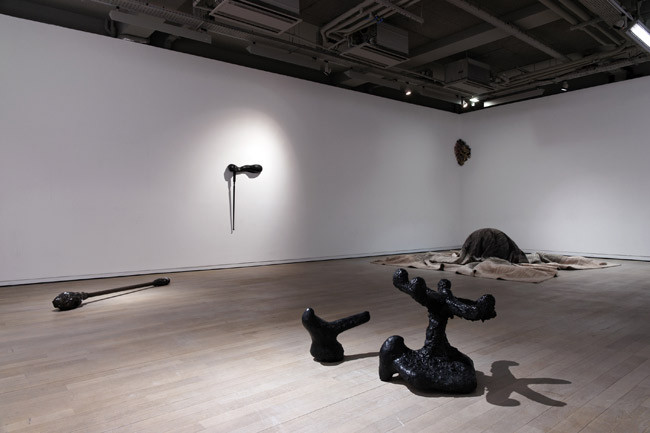WANI
08 Apr - 21 May 2011
WANI
Curated by Paul Ardenne and Marie Maertens
8 April - 21 May, 2011.
With Dorota Buczkowska, Fia Cielen, Julien Discrit, Florence Doléac, Hubert Duprat, Camille Henrot, Jean-Claude Jolet, Vincent Kohler, Emmanuelle Lainé, Fabrice Langlade, Farida Le Suavé, Michael et Florian Quistrebert, Thomas Rentmeister, Anders Ruhwald, Semiconductor, Philippe Terrier-Hermann, Laurent Tixador and Anne Wenzel.
This exhibition is devoted to "WANI" art. The neologism is the oral contraction of OANI, which stands for "Objet Artistique Non Identifié" or even "Oeuvre d'Art Non Identifiable."
"WANI" aims to highlight a type of artwork that poses a genuine analytical challenge - works that ostensibly do not mean anything, due to a voluntarist choice not to. More subtly, these works - whose non-explicit nature results from a firm decision on the part of their creators - represent a real gamble: escaping any hijacking, whether theoretical, in the name of a given lineage, or owing to a statement in the plastic arts clearly announced or identifiable. They even escape their authors' grasp: facing the WANI works, artists too find themselves meditative and powerless. The first WANI in art history, a fictitious one, may then be La Belle Noiseuse painted by Frenhofer in Balzac's Le Chef-d'oeuvre inconnu (The Unknown Masterpiece) - at least, the part of the painting that remains an enigma, and whose secret seems to have claimed the very life of its author. As a precaution, the artist is then left saying, in the manner of a Cocteau character, "since these mysteries are beyond me, let's pretend we're organizing them."
Accordingly, WANI art is not without interest, as hard as it may try to conceal the fact... It places spectators in an attitude of perplexity that forces them to consider the work as a paradox: a problematic entity, since it remains mute on its purpose and its meaning, it is still aesthetically active. The WANI work of art, once become a disturbing object of interposition, may be overlooked but with difficulty. Like any enigma, it calls forth reflection, at once activating the "pensive" look and causing exasperation. Obviously, no matter from which side you approach things - in this case, an art resisting analysis, explanation, expertise, the statement of a truth - there is nothing to understand. The true subversion might lie there, not in the revolutionary and angry upheaval of signifiers, but in the staging of a value that remains impossible to qualify.
Curated by Paul Ardenne and Marie Maertens
8 April - 21 May, 2011.
With Dorota Buczkowska, Fia Cielen, Julien Discrit, Florence Doléac, Hubert Duprat, Camille Henrot, Jean-Claude Jolet, Vincent Kohler, Emmanuelle Lainé, Fabrice Langlade, Farida Le Suavé, Michael et Florian Quistrebert, Thomas Rentmeister, Anders Ruhwald, Semiconductor, Philippe Terrier-Hermann, Laurent Tixador and Anne Wenzel.
This exhibition is devoted to "WANI" art. The neologism is the oral contraction of OANI, which stands for "Objet Artistique Non Identifié" or even "Oeuvre d'Art Non Identifiable."
"WANI" aims to highlight a type of artwork that poses a genuine analytical challenge - works that ostensibly do not mean anything, due to a voluntarist choice not to. More subtly, these works - whose non-explicit nature results from a firm decision on the part of their creators - represent a real gamble: escaping any hijacking, whether theoretical, in the name of a given lineage, or owing to a statement in the plastic arts clearly announced or identifiable. They even escape their authors' grasp: facing the WANI works, artists too find themselves meditative and powerless. The first WANI in art history, a fictitious one, may then be La Belle Noiseuse painted by Frenhofer in Balzac's Le Chef-d'oeuvre inconnu (The Unknown Masterpiece) - at least, the part of the painting that remains an enigma, and whose secret seems to have claimed the very life of its author. As a precaution, the artist is then left saying, in the manner of a Cocteau character, "since these mysteries are beyond me, let's pretend we're organizing them."
Accordingly, WANI art is not without interest, as hard as it may try to conceal the fact... It places spectators in an attitude of perplexity that forces them to consider the work as a paradox: a problematic entity, since it remains mute on its purpose and its meaning, it is still aesthetically active. The WANI work of art, once become a disturbing object of interposition, may be overlooked but with difficulty. Like any enigma, it calls forth reflection, at once activating the "pensive" look and causing exasperation. Obviously, no matter from which side you approach things - in this case, an art resisting analysis, explanation, expertise, the statement of a truth - there is nothing to understand. The true subversion might lie there, not in the revolutionary and angry upheaval of signifiers, but in the staging of a value that remains impossible to qualify.

